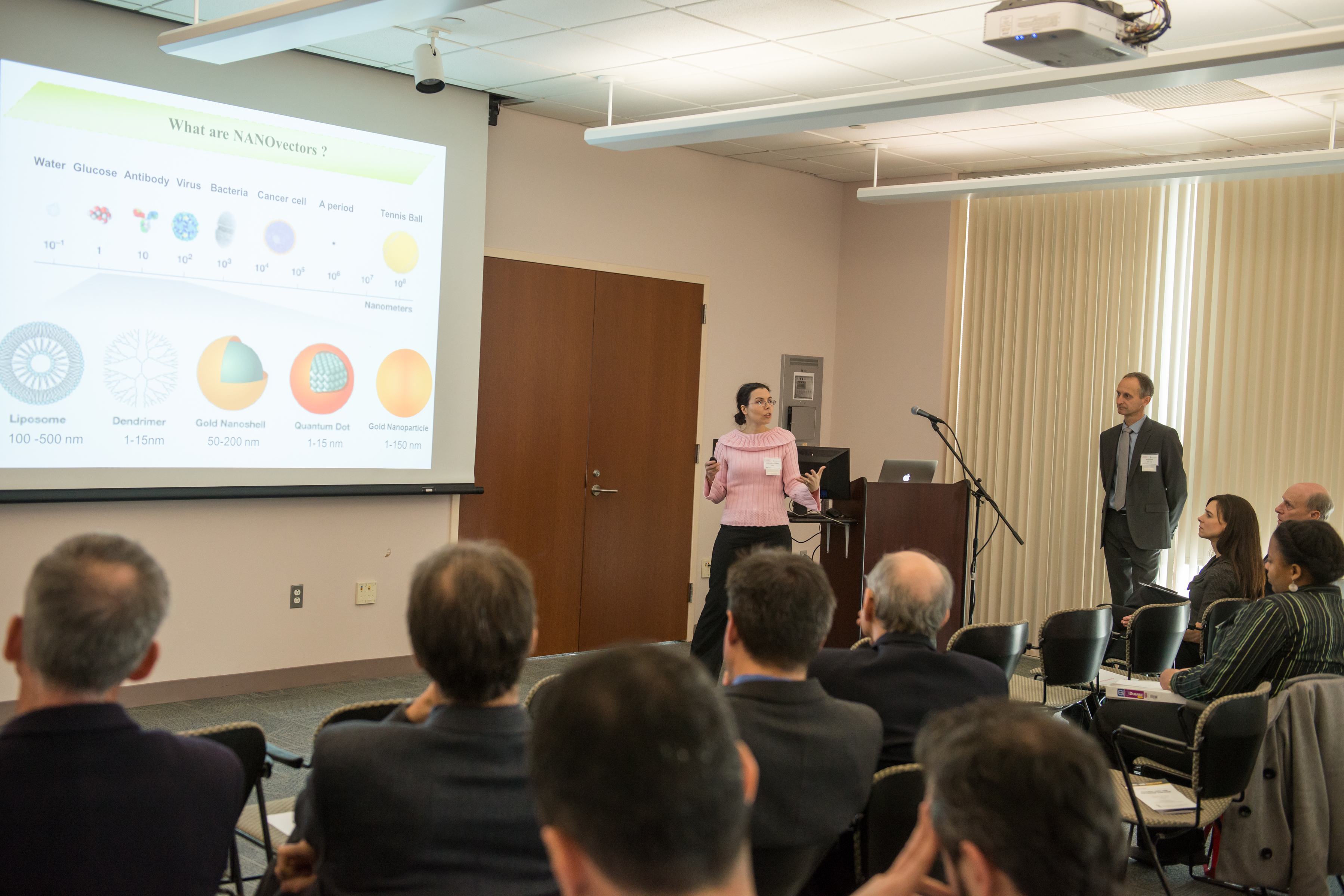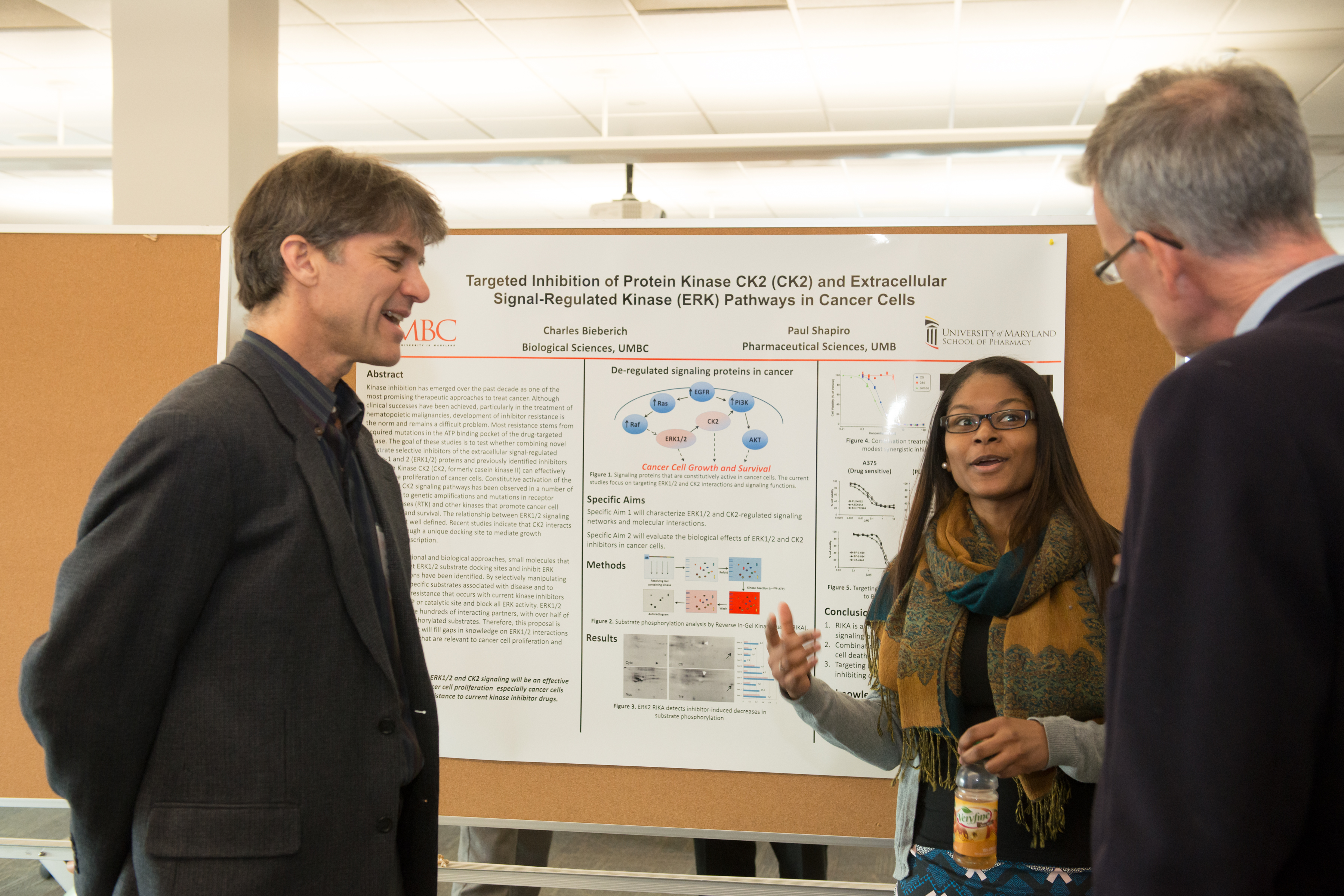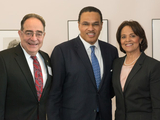UMBC-UMB Partnership Symposium celebrates collaboration
New grants awarded and previous recipients report progress
Inaugural UMBC-UMB Research and Innovation Partnership Symposium celebrates cross-campus collaboration
By Sarah Hansen
Right: UMB President Jay Perman (left), UMBC President Freeman Hrabowski (center), and Acting Director of the National Institute of Minority Health and Health Disparities Yvonne Maddox
The first annual UMBC-UMB Research and Innovation Partnership Symposium held on January 30, 2015 in the Albin O. Kuhn Library at UMBC celebrated partnerships between the University of Maryland, Baltimore County and University of Maryland, Baltimore. The program specifically highlighted recipients of the UMBC-UMB Research and Innovation Partnership Grant Program. Initiated in 2013, the program awards up to $150,000 over up to 24 months for research projects led by teams including both UMBC and UMB faculty.
UMBC President Freeman Hrabowski opened the symposium with an African proverb: “If you want to go fast, you go alone. If you want to go far, you go together.” That spirit of collaboration permeated this historic event.
Success Stories
UMBC Associate Professor of Chemistry and Biochemistry Marie-Christine Daniel, who received a partnership grant last year for her work with UMB Professor of Pharmaceutical Sciences Peter Swann, commented, “Peter and I have complementary expertise, and thanks to the partnership grant, that actually gave us the opportunity to start interacting and working on this project.” The team’s research seeks to develop a new drug delivery system using nanoparticles. Other recipients echoed Daniel’s sentiments regarding the importance of interdisciplinary partnerships.

Daniel (center) and Swann (right) present their research on a nanoparticle-based drug delivery system.
“Collaborations with Kathleen [Hoffman] in the [UMBC] math department were instrumental,” said Asaf Keller, UMB Professor of Anatomy and Neurobiology. His research focuses on determining what’s happening in the brains of patients suffering from chronic pain. He hopes new knowledge will open the door for new treatment methods. “[Working with Hoffman] allowed us to ask questions that we cannot ask experimentally,” he said.
UMBC Professor of Biological Sciences Charles (Chuck) Biebrich is working with UMB Professor of Pharmaceutical Sciences Paul Shapiro. Shapiro’s research focuses on developing new drugs that target treatment-resistant cancer cells, and Biebrich is developing a method for evaluating the new drugs’ efficacy. “We were able to show, using the support of our seed grant, that this actually does work,” Biebrich said. “Twenty-five percent of all pharma R&D is doing the same category of work Paul is doing,” he said, so the benefit of Biebrich’s work will be widespread.
Kelly Westlake, Assistant Professor of Physical Therapy and Rehabilitation at UMB, uses imaging techniques and clinical rehabilitation to study motor control recovery in stroke patients. She teamed up with UMBC Professor of Computer Science and Electrical Engineering Tülay Adali, whose programming skills allowed them to visualize small changes in stroke patients’ brains before and after different rehabilitation interventions. Westlake also commented, “It was really the seed grant that helped us forge ahead.”
But these grants don’t only affect faculty members. “The most rewarding and tangible result of having access to these seed grants was our ability to co-train or co-mentor students,” said Keller. He and Hoffman were able to train two additional graduate students: a math student at UMBC learned some biological techniques from Keller, and Hoffman taught a student from the UMB School of Medicine computational modeling skills.
This year’s partnership grant recipients were also announced at the symposium.

Shapiro (left) and Biebrich (right) discuss their project, which aims to develop effective drugs for treatment-resistant cancer cells, with a student.
Keynote Inspiration
Keynote speaker Yvonne Maddox, Acting Director of the National Institute of Minority Health and Health Disparities, was the perfect centerpiece to the symposium’s program. “Dr. Maddox has practiced and championed why we are here today,” said Bill LaCourse, Dean of the College of Natural and Mathematical Sciences at UMBC. “She knows about partnerships.” Maddox was thrilled to have the opportunity to speak at the symposium. “To be here on this campus when you are collaborating and working together… You are the universities of the future,” she said.
She advocated for the new science of health disparities and even asked for the audience’s help in shaping the burgeoning field. She acknowledged past progress but also the need for much more. “We’ve done almost everything we can above the iceberg,” she said in reference to reducing infant mortality, one of her priorities, but “two-thirds of the iceberg is under the water level. Let’s look under the water level.” And how are we going to accomplish deeper, long-lasting change? “Partnerships are going to help us,” she stated.
Maddox also promoted the need for a diverse workforce. The NIH recently awarded UMBC $18 million through the Building Infrastructure Leading to Diversity (BUILD) grant program. “The BUILD program is just the cat’s whiskers,” she said. “It’ll make it happen. I’m convinced.”
UMB President Jay Perman captured the symposium’s positive, action-driven vibe in his opening address. “We’re preaching to the choir here. You’ve seen the power of collaboration, you’ve led by collaboration,” he said. “I want you to diffuse it out and tell your colleagues who haven’t quite discovered the opportunities that the two campuses have together to go and grab them.” And most importantly, “We’ll support them.”
Dr. Maddox's presentation is attached below.
By Sarah Hansen
Right: UMB President Jay Perman (left), UMBC President Freeman Hrabowski (center), and Acting Director of the National Institute of Minority Health and Health Disparities Yvonne Maddox
The first annual UMBC-UMB Research and Innovation Partnership Symposium held on January 30, 2015 in the Albin O. Kuhn Library at UMBC celebrated partnerships between the University of Maryland, Baltimore County and University of Maryland, Baltimore. The program specifically highlighted recipients of the UMBC-UMB Research and Innovation Partnership Grant Program. Initiated in 2013, the program awards up to $150,000 over up to 24 months for research projects led by teams including both UMBC and UMB faculty.
UMBC President Freeman Hrabowski opened the symposium with an African proverb: “If you want to go fast, you go alone. If you want to go far, you go together.” That spirit of collaboration permeated this historic event.
Success Stories
UMBC Associate Professor of Chemistry and Biochemistry Marie-Christine Daniel, who received a partnership grant last year for her work with UMB Professor of Pharmaceutical Sciences Peter Swann, commented, “Peter and I have complementary expertise, and thanks to the partnership grant, that actually gave us the opportunity to start interacting and working on this project.” The team’s research seeks to develop a new drug delivery system using nanoparticles. Other recipients echoed Daniel’s sentiments regarding the importance of interdisciplinary partnerships.
Daniel (center) and Swann (right) present their research on a nanoparticle-based drug delivery system.
“Collaborations with Kathleen [Hoffman] in the [UMBC] math department were instrumental,” said Asaf Keller, UMB Professor of Anatomy and Neurobiology. His research focuses on determining what’s happening in the brains of patients suffering from chronic pain. He hopes new knowledge will open the door for new treatment methods. “[Working with Hoffman] allowed us to ask questions that we cannot ask experimentally,” he said.
UMBC Professor of Biological Sciences Charles (Chuck) Biebrich is working with UMB Professor of Pharmaceutical Sciences Paul Shapiro. Shapiro’s research focuses on developing new drugs that target treatment-resistant cancer cells, and Biebrich is developing a method for evaluating the new drugs’ efficacy. “We were able to show, using the support of our seed grant, that this actually does work,” Biebrich said. “Twenty-five percent of all pharma R&D is doing the same category of work Paul is doing,” he said, so the benefit of Biebrich’s work will be widespread.
Kelly Westlake, Assistant Professor of Physical Therapy and Rehabilitation at UMB, uses imaging techniques and clinical rehabilitation to study motor control recovery in stroke patients. She teamed up with UMBC Professor of Computer Science and Electrical Engineering Tülay Adali, whose programming skills allowed them to visualize small changes in stroke patients’ brains before and after different rehabilitation interventions. Westlake also commented, “It was really the seed grant that helped us forge ahead.”
But these grants don’t only affect faculty members. “The most rewarding and tangible result of having access to these seed grants was our ability to co-train or co-mentor students,” said Keller. He and Hoffman were able to train two additional graduate students: a math student at UMBC learned some biological techniques from Keller, and Hoffman taught a student from the UMB School of Medicine computational modeling skills.
This year’s partnership grant recipients were also announced at the symposium.
Shapiro (left) and Biebrich (right) discuss their project, which aims to develop effective drugs for treatment-resistant cancer cells, with a student.
Keynote Inspiration
Keynote speaker Yvonne Maddox, Acting Director of the National Institute of Minority Health and Health Disparities, was the perfect centerpiece to the symposium’s program. “Dr. Maddox has practiced and championed why we are here today,” said Bill LaCourse, Dean of the College of Natural and Mathematical Sciences at UMBC. “She knows about partnerships.” Maddox was thrilled to have the opportunity to speak at the symposium. “To be here on this campus when you are collaborating and working together… You are the universities of the future,” she said.
She advocated for the new science of health disparities and even asked for the audience’s help in shaping the burgeoning field. She acknowledged past progress but also the need for much more. “We’ve done almost everything we can above the iceberg,” she said in reference to reducing infant mortality, one of her priorities, but “two-thirds of the iceberg is under the water level. Let’s look under the water level.” And how are we going to accomplish deeper, long-lasting change? “Partnerships are going to help us,” she stated.
Maddox also promoted the need for a diverse workforce. The NIH recently awarded UMBC $18 million through the Building Infrastructure Leading to Diversity (BUILD) grant program. “The BUILD program is just the cat’s whiskers,” she said. “It’ll make it happen. I’m convinced.”
UMB President Jay Perman captured the symposium’s positive, action-driven vibe in his opening address. “We’re preaching to the choir here. You’ve seen the power of collaboration, you’ve led by collaboration,” he said. “I want you to diffuse it out and tell your colleagues who haven’t quite discovered the opportunities that the two campuses have together to go and grab them.” And most importantly, “We’ll support them.”
Dr. Maddox's presentation is attached below.
- Attached Image for UMBC-UMB Partnership Symposium celebrates collaboration
- Attached Image for UMBC-UMB Partnership Symposium celebrates collaboration
- Attached Presentation for UMBC-UMB Partnership Symposium celebrates collaboration
- Attached Image for UMBC-UMB Partnership Symposium celebrates collaboration
Tags:
Posted: February 12, 2015, 9:33 PM
